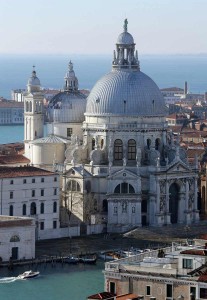
©Bigstock.com/ChiccoDodiFC
Throughout its illustrious history, Venice was afflicted by several devastating plague epidemics leaving its marks on the public, the landscape and even the city panorama. Various churches and memorial sites commemorate the countless plague victims as do two very special festivities, both of which are based on gratitude processions that took place after the plague had finally left the city. Aside from La Festa del Redentore, the Feast of the Redeemer held annually on the third weekend in July, the Festa della Madonna della Salute takes place every November 21st.
The plague epidemics of 1630 and 1631
Over the course of its long, illustrious history, Venice saw itself confronted with humanitarian catastrophes and severe epidemics repeatedly. The city’s exposed location and its significance as a national and international trade route benefitted the outbreak of epidemics. Venice, however, was prepared after the devastating plague catastrophe of 1575 to 1577. Arriving ships were controlled by the health authorities, strict hygiene regulations introduced and the world’s first quarantine station opened. Nevertheless, the city virtually imported the plague in the spring of 1630, as a diplomat of the Duke of Mantua and his entourage brought the deadly pestilence to Venice. There were already more than 1,200 fatalities after three months. By the time the plague had abated in October 1631, 46,536 of the approx. 140,000 Venetians had perished. Once the “divine anger” had finally subsided and its traces were yet to be disposed of, bidding for a very special house of prayer began.
50,000 ducats for a church
Venice’s Senate issued a resolution on 22 October 1630; a promise to the Blessed Virgin Mary, to be more precise. 50,000 ducats were promised for the construction of a church in her honour in gratitude for deliverance. It didn’t take long to find a name for it either: Santa Maria della Salute. The planning process began the following year, right after the deadly epidemic had subsided. Baldassare Longhena was assigned with the task of building the church directly at the entrance to Canal Grande. However, before construction works could begin, over a million tree trunks had to be driven into the lagoon ground to stabilise the foundation soil costing the entire 50,000 ducats.
Henceforth, constructions would drag on and on. Venice struggled with financial problems, never managed to fully recover from the plague epidemic and lost its special position as a centre of trade forever. Construction works were disrupted multiple times until the church was eventually – and finally – completed in 1687. By this time, the financially strapped city had spent 420,136 ducats. Longhena had already passed away five years earlier.
Baroque work of art at Canal Grande
Baldassare Longhena intended to emphasise Venice’s grandezza and special position with the basilica Santa Maria della Salute. The architect himself would not see the completion of his monumental baroque structure and the city itself never managed to regain its former glory either. The church, however, still radiates astonishing glory to this day making it one of the city’s landmarks. Eight spectacular sides, two cupolas, two campanili and the full marble siding impress. Longhena intended to create an alternative to the prevalent Roman baroque style by mainly using light and shade, important elements of Venetian architecture.
Inside, the church initially seems to have been designed rather soberly and plainly, but the proverbial appearance is deceiving. Don’t be fooled by neither the grey plastering nor the white stone, as the fascinating marble floor with its particularly significant inlays and the equally spectacular altars impress in their very own unique way. Glorious paintings by Tintoretto, Titian and Salviati slickly complete the imposing appearance.
The festivity
Like the Festa del Redentore, a special water bridge is built for the Festa della Madonna della Salute. It crosses Canal Grande and becomes the site for the ceremonial, atmospheric procession leading from the church Santa Maria del Giglio to the basilica Madonna della Salute. On November 21st, services are held non-stop from 8 am until the evening. Market stalls alongside the procession offer cake and cotton candy as well as candles for the pilgrims. Naturally, the traditional dish of the feast must be provided as well: Castradina – salted, smoked mutton with savoy cabbage.
Many other small festivities you absolutely shouldn’t miss either take place around November 21st. Children love the many attractions and sweets that offer a first taste of the approaching Advent season. The mood among adults is rather interesting – merrymaking and festive joy on one hand, thankfulness for one’s health and quiet reflection on the other hand.
November 21st is one of the most important and at the same time most beautiful Venetian holidays. You should absolutely try to include the Festa della Madonna della Salute in your holiday plans. There are certainly many more suggestions and ideas for your next trip to Venice to be found on ZAINOO. Have fun planning your upcoming visit!